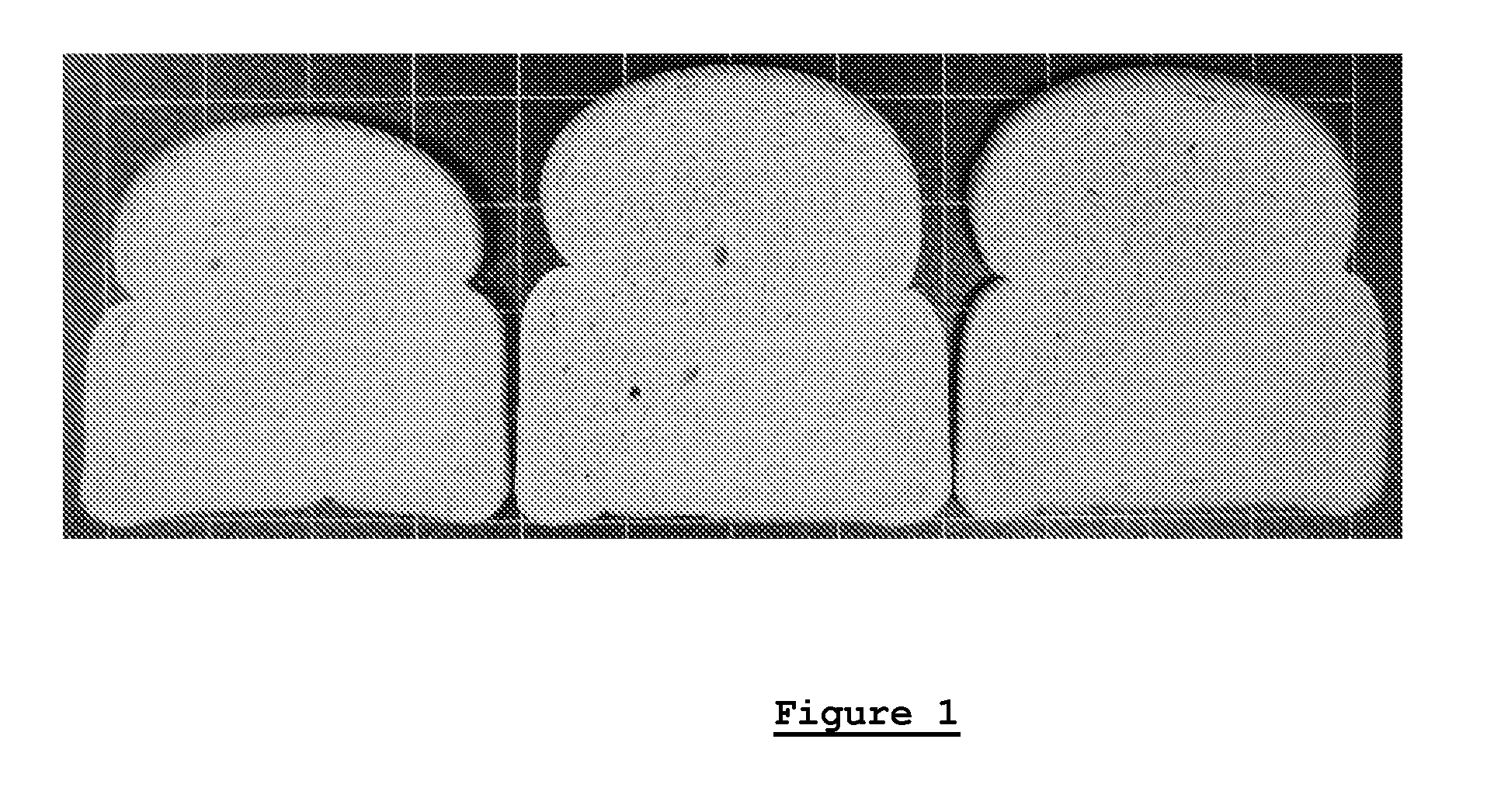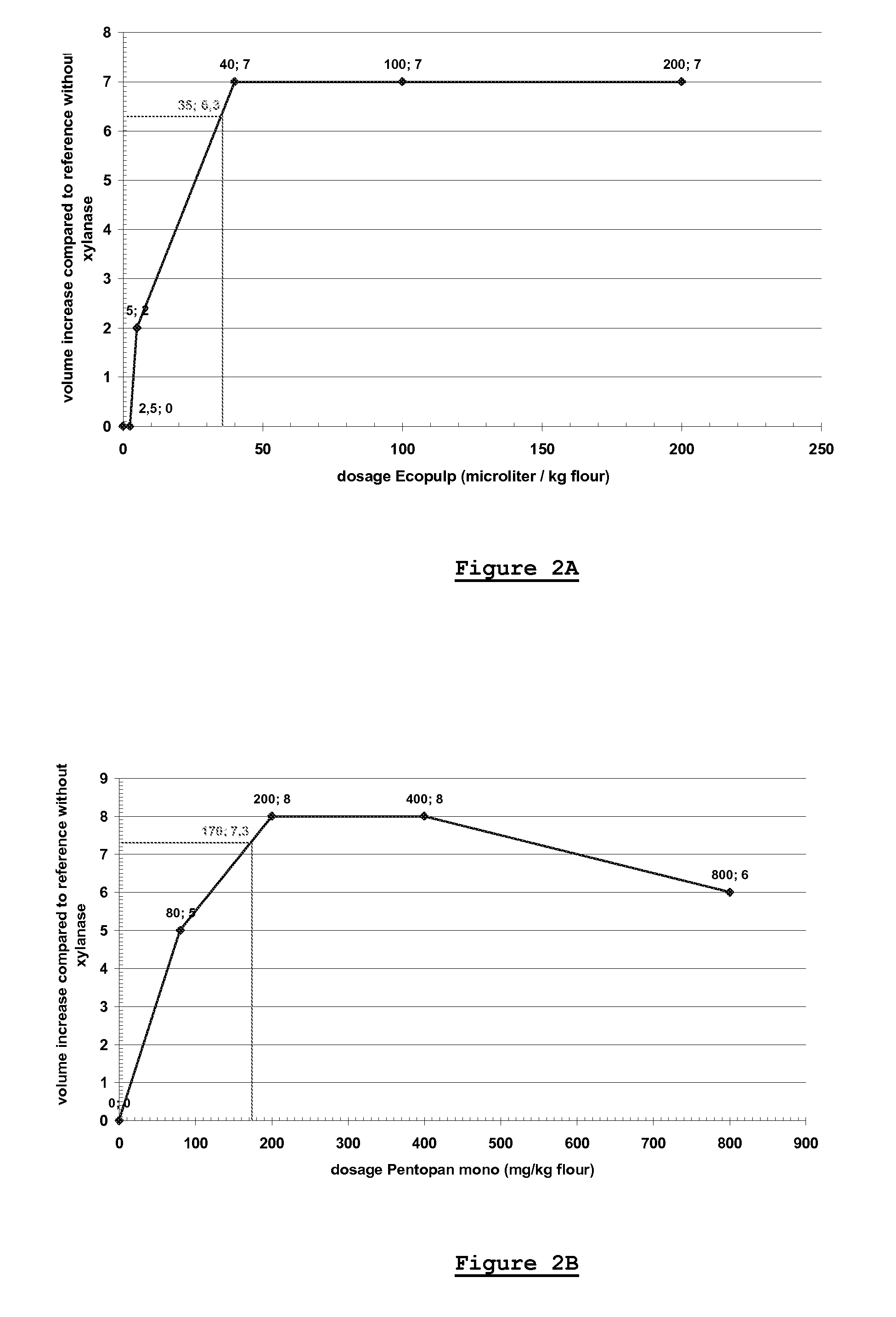Bread with increased arabinoxylo-oligosaccharide content
a technology of arabinoxylooligosaccharide and bread, which is applied in the field of bread with increased arabinoxylooligosaccharide content, can solve the problems of gas retention reduction, achieve the effects of reducing gas retention, reducing gas retention, and increasing the viscosity of the aqueous phase of the dough
- Summary
- Abstract
- Description
- Claims
- Application Information
AI Technical Summary
Benefits of technology
Problems solved by technology
Method used
Image
Examples
example 1
Materials:
[0155]Frimase® B210 (XBS) is a commercial food-grade endoxylanase preparation from Puratos (Groot-Bijgaarden, Belgium) produced through expression in Bacillus subtilis of a Bacillus subtilis GH 11 endoxylanase gene.
[0156]Frimase®218 (XPH) is a commercial food-grade endoxylanase preparation from Puratos (Groot-Bijgaarden, Belgium) produced through recombinant expression of a Pseudoalteromonas haloplanktis GH8 endoxylanase gene.
[0157]Grindamyl® Powerbake® (GRIN PB) is a commercial food-grade endoxylanase preparation from Danisco (Copenhagen, Denmark) produced through expression in Bacillus subtilis of a non-inhibited mutant of a Bacillus subtilis GH 11 endoxylanase gene.
[0158]Ecopulp® TX200A (ECOP) is a commercial technical grade endoxylanase preparation from AB Enzymes (Darmstadt, Germany) produced through recombinant expression of a thermophilic mutant of a Trichoderma longibrachiatum GH11 endoxylanase gene.
[0159]Multifect® Xylanase (MF XYL) is a commercial technical grade...
example 2
Materials:
[0193]Specifications of the enzymes used are provided in example 1 and Table 1.
[0194]Rye endosperm flour type 1150 and rye flour type 1740 were purchased from Plange Mühle (Düsseldorf, Germany). The wheat endosperm (white) flour was either type 550 from Plange Mühle or brand Surbi®) from Dossche Mills & Bakery (Deinze, Belgium). The rye bran was the Rye Bran Beaten brand from Hildebrandmühlen (Frankfurt, Germany).
Analytical Techniques:
[0195]Determination of the T-AX, S-AX content and the average DP of S-AX were performed as described in example 1.
Baking Tests:
[0196]Breads prepared with a mixture of 70% rye endosperm flour type 1150 and 30% wheat endosperm flour type 550 were prepared by mixing 1050 g rye flour, 450 g wheat flour, 33 g salt, 37.5 g yeast (Algist Bruggeman, Gent, Belgium), 73.5 g sourdough (Aroldo, Puratos, Belgium), 1245 g water, and the appropriate amount of endoxylanase preparations (as specified in the Table 6). Mixing was done for 5 minutes at low speed...
example 3
Materials:
[0204]Specifications of the enzymes used are provided in example 1 and Table 1.
[0205]Wheat endosperm (white) flour (Surbi®) was obtained from Dossche Mills & Bakery (Deinze, Belgium).
[0206]Preparation of an AXOS-rich ingredient was done as follows. A suspension of wheat bran in water (1:7 w / v) was first treated with a thermostable α-amylase (Termamyl 120LS, Novozymes, Bagsvaerd, Denmark; 1 μl / g wheat bran) for 90 min at 90° C. under continuous stirring to hydrolyse the starch. The suspension was filtered and the filtrate discarded. The residue was resuspended in water (1:7 w / v) and incubated under continuous stirring for 8 h at 52° C. with a GHF11 endoxylanase from Bacillus subtilis (Grindamyl H640, Danisco, Denmark) at 11 units per g destarched bran. After endoxylanase treatment, the suspension was filtered with recovery of the filtrate. After inactivation of the enzyme by treatment (90° 10 min), the solution was concentrated till 20% dry matter in a falling film evaporat...
PUM
 Login to View More
Login to View More Abstract
Description
Claims
Application Information
 Login to View More
Login to View More - R&D
- Intellectual Property
- Life Sciences
- Materials
- Tech Scout
- Unparalleled Data Quality
- Higher Quality Content
- 60% Fewer Hallucinations
Browse by: Latest US Patents, China's latest patents, Technical Efficacy Thesaurus, Application Domain, Technology Topic, Popular Technical Reports.
© 2025 PatSnap. All rights reserved.Legal|Privacy policy|Modern Slavery Act Transparency Statement|Sitemap|About US| Contact US: help@patsnap.com


